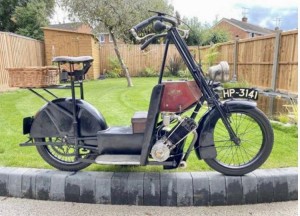NOW FOR SALE WITH H&H CLASSICS AT THE NMM ON OCT 27TH
H&H Classics will offer two rare and intriguing Kenilworth machines from the post WW1 period at the National Motorcycle Museum on October 27 – one a stand-up scooter and the other with a seat. Top speeds were between 15 and 20mph.
The Scooter BF8876 is the earliest known Kenilworth machine, a 1919 prototype and a Motorcyclette HP 3141, the only one known to be in road worthy condition, original number. Both are estimated to sell or £5,500 to £6,500.
This Kenilworth Scooter BF8876 is known as Lenny and is the oldest known example, and most probably a prototype: a rare and original survivor from a brief period of motorcycling history.
Lenny is a very original machine, and great attention to detail has gone into making sure his history has been correctly preserved. It has been featured in the VMCC Journal and is believed to be running well. It comes complete with V5c and VMCC dating certificate.

The Kenilworth Motorcyclette machine (above) which includes the luxury of a seat, was purchased in 2005 from the Murray Motorcycle museum on the Isle of Man where it had been for about thirty years, no previous history known. It has been in regular use, Banbury run, Graham Walker run etc. and used for local shopping trips!
These Kenilworth machines were designed by Captain Smith Clarke and produced 1920 to 1924. Production machines were manufactured by Booth Brothers of Coventry. Booth Brothers later went on to manufacture Alvis cars, with Captain Smith Clarke as chief designer.
The first Kenilworth machine was a ‘stand-up’ scooter powered by an overhead valve Norman engine of 142cc. It had single speed direct drive and one cycle type brake. There was no suspension. This 102-year-old machine can deliver a speed of around 15 miles per hour.
In late 1920 the Kenilworth Miniature was introduced. This was basically the Scooter with a sprung seat pillar, saddle, battery- powered electric lighting and two brakes, the rear being the contracting band type.
The introduction of the Motorcyclette in 1921 saw a re-designed, fully tubular frame with sweptback handlebars and leg shields. The engine and transmission were unchanged but still no front suspension!
The last of the miniatures appeared in 1923 with friction drive. This was the Motorcyclette with its engine mounted across the frame driving a Neracar-type mechanism. It also had a clutch and a crank handle for starting.
In 1924, Kenilworth produced its last model a conventional miniature motorcycle using the existing friction drive set up. Front suspension was by Supreme forks, and 24” wheels were used.
How many were produced? From known engine numbers about five hundred and fifty over five years. There are ten known survivors, some incomplete and others in museums, three Scooters, three Miniatures, three Motorcyclettes and four Friction Drives. As far as is known only three of these are complete and in road use, two scooters and one Motorcyclette.




 Coventry Road
Coventry Road
No comments yet.